Monthly Archives: July 2013
Large Plants – Folio 20v
Large Plants – Folio 20r
Large Plants – Folio 19v
Large Plants – Folio 19r
Voynich Large Plants – Folio 18v
This is a plant ID I posted 4 1/2 years ago. As some readers may have noticed, I uploaded many plant IDs in July 2013, but took down more than half of them about a week later because I was eager to solve the VMS and felt I might be giving too much away, but since the VMS has not yet been solved, as of Feb. 2018, I’ve had a change of heart and have decided to post them again as I have time. I haven’t changed the original text because I haven’t seen anything in the interim that alters my opinion about this plant.
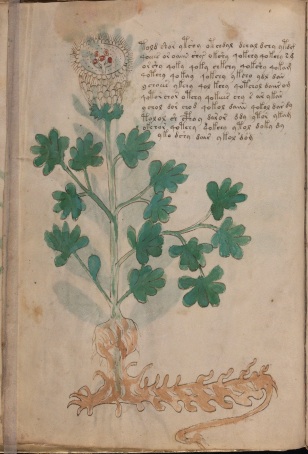 Description
Description
Plant 18v features a large drawing occupying most of the page. There is a ten-line block of text to the right at the top.
The stalk is quite upright and lightly painted. The leaves are a fairly solid green and fan-like, with about six rounded tips per leaf. The way they are attached to the stalk is variable—sometimes alternate, sometimes opposite. Some plants are like this, but most tend to lean toward one or the other.
The root has two sections, more bulbous near the stalk, with a long rhizome at the base. It is selectively painted a light reddish-brown and includes a long “tail” that might be characteristic of the plant (some plants have extended rhizomes that are more slender) or which might be symbolically related to the identity of the plant. There are protrusions from the rhizome shaped a bit like a caterpillar.
Prior Identifications
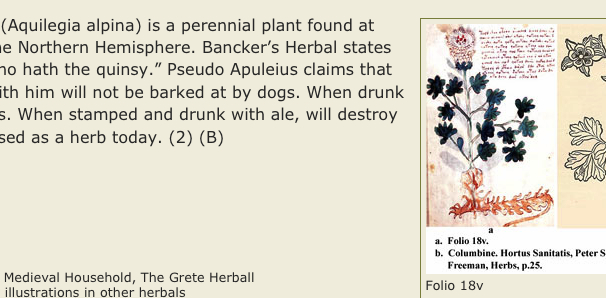 Edith Sherwood has identified this as columbine (Aquilegia alpina), perhaps because colombine leaves are somewhat fingerlike, but I don’t think it’s a very good fit. Colombine leaves do fan out, but they are also trifoliate, which the VMS leaves are not, and colombine does not have an elaborate, extended, branched style/pistil. In fact, one of the distinctive characteristics of colombine is that the flowers nod and have spurs extending toward the sky, something that is not expressed in any way in the VMS drawing.
Edith Sherwood has identified this as columbine (Aquilegia alpina), perhaps because colombine leaves are somewhat fingerlike, but I don’t think it’s a very good fit. Colombine leaves do fan out, but they are also trifoliate, which the VMS leaves are not, and colombine does not have an elaborate, extended, branched style/pistil. In fact, one of the distinctive characteristics of colombine is that the flowers nod and have spurs extending toward the sky, something that is not expressed in any way in the VMS drawing.
Other Possibilities
I only have a few candidates for Plant 18v and I’m not satisfied that the first three are close enough, but I’ll mention them, for the record:
- Plant 18v leaves are very similar to Lady’s mantle (Alchemilla vulgaris), a plant with a woody rhizome included in many herbal manuscripts, but if the VMS depicts Alchemilla, then the tiny clusters of flowers have been greatly magnified and modified. It doesn’t seem likely that Alchemilla flowers would be drawn this way. VMS Plant 23r is much more similar to Alchemilla than 18v—with fingerlike leaves, branching flower clusters, and the thick matted growth pattern clearly expressed in Plant 23r.
- There is also a species of Convolvulus (known to many as morning glory or bindweed) that has fingerlike leaves and a number of protrusions within the petals, but unlike the VMS drawing, it’s a viny plant that grows lower to the ground, and the style/pistil doesn’t resemble the VMS drawing.
- Geranium molle (dove’s-foot cranesbill) also has fingerlike leaves, but the leaves are more elaborate than the VMS and, like Convolvulus, the plant is somewhat viny and low-growing. Geranium molle does, however, have a branched style/pistil with little knobs on the end (I prefer to stay away from botanical terms because “knobs” are not always stigmas and anthers), so perhaps it’s not unreasonable to keep Geranium molle as a possibility, but it’s not at the top of my list because the overall shape of the plant and complexity of the leaves is dissimilar to Plant 18v.
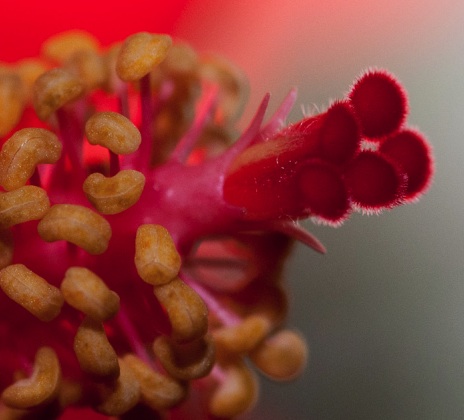
Some species of hibiscus have five distinctive rounded red enlargements at the end of the pistil. [Image detail courtesy of Jawahar Swaminathan]
Different species of hibiscus have somewhat variable leaves, but quite a few of them have fan- or hand-shaped leaves.
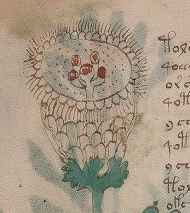 If you peel away the petals on Althea (Malva), the plants commonly called hibiscus and hollyhock, the pistils of some species might be drawn like Plant 18v, and the leaves are a pretty good match as well. On some species the red knobs are close together, as in the photograph above, and in some they are splayed apart, as in the VMS drawing.
If you peel away the petals on Althea (Malva), the plants commonly called hibiscus and hollyhock, the pistils of some species might be drawn like Plant 18v, and the leaves are a pretty good match as well. On some species the red knobs are close together, as in the photograph above, and in some they are splayed apart, as in the VMS drawing.
Althaea rosea, a hollyhock that grows in the Balkins, has a long row of protrusions along the pistil, similar to a bottlebrush. The leaves are palmate, but not quite as fingerlike as Plant 18v.
Malva maritima has more fingerlike leaves, and quite an elaborate style/pistil attachment with a starlike whorl of five leaflets. It also has protrusions at the end of the style/pistil, but does not have the very distinctive red matchstick-like ends protruding beyond the fuzzy parts that we see in the VMS drawing.
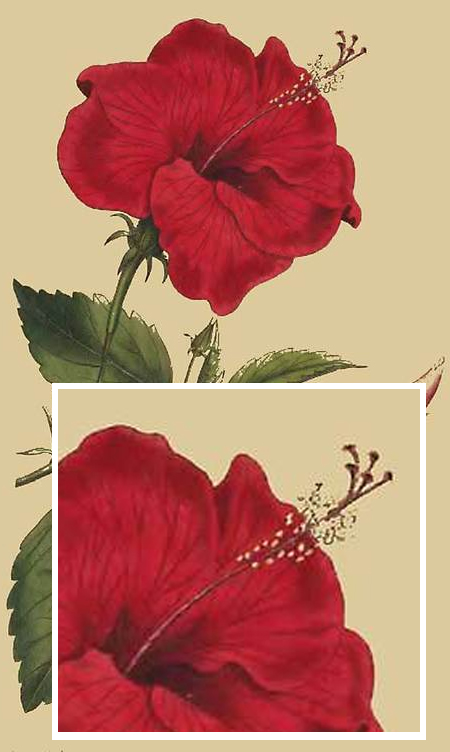 Hibiscus rosa-sinensis (left), a hibiscus that grows in Malaysia, has a particularly distinctive protrusion, with five branching knobs and a bottlebrush spray. The ends are bright red, as in the VMS drawing, but H. rosa-sinensis does not have fingerlike leaves, they are elliptical, so it’s not quite a match.
Hibiscus rosa-sinensis (left), a hibiscus that grows in Malaysia, has a particularly distinctive protrusion, with five branching knobs and a bottlebrush spray. The ends are bright red, as in the VMS drawing, but H. rosa-sinensis does not have fingerlike leaves, they are elliptical, so it’s not quite a match.
Malva neglecta has more fingerlike leaves but lacks the five distinctive red bulbs at the end of the style.
As with many VMS drawings, it’s hard to narrow it down to a single species, but Althea/Malva strikes me as being more similar to the VMS drawing than other kinds of plants and the distinctive five-branched style/pistil is not common in the plant world and thus is a good detail for remembering the plant.
I did find one other plant with a similar pistil, split into several bulbous ends, but the leaves were not a good match for the VMS, so I’m leaving it on the backburner for now.
J.K. Petersen
P.S.: The New World passion flower has a distinctive branching style/pistil, but the plant, as a whole, tends to be more viny than the VMS plant drawing, has variable numbers of branches on the style and doesn’t usually have the distinctive matchstick-like red knobs as are found in hibiscus. Also, the leaves of most species of passion flower are trifoliate and those that are more fingerlike don’t quite have a fan shape, each leaflet is usually more separate from the others. The fruits of passion flower are also quite distinctive and are frequently included in botanical drawings and the VMS plant doesn’t include fruit.
For those interested in botanical history, the passion flower was thought to be a species of clematis for a couple of centuries after the New World was colonized by Europeans. They do look similar in a number of ways, but Clematis is actually more closely related to the buttercup (Ranunculus) than to the Passiflorae.
Large Plants – Folio 18r
Large Plants – Folio 17v
Voynich Large Plants – Folio 17r
The Plant with the Mysterious Root
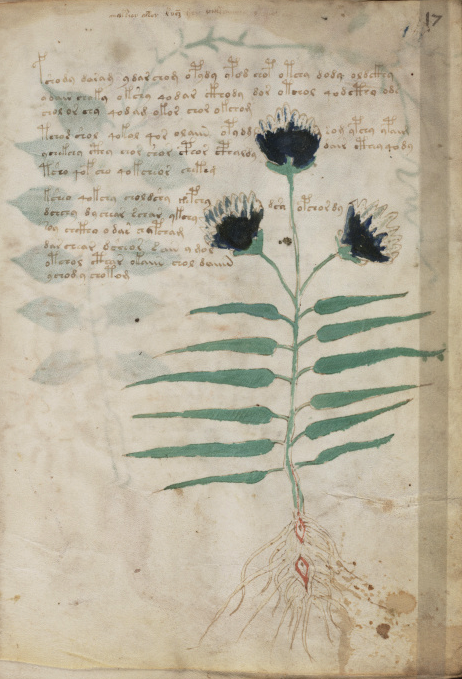 Plant 17r is a slender plant with a stem that branches at the top. Three puffs of blossoms are painted dark blue toward the calyx, but left unpainted across the top. This might suggest a two-toned blossom, or possibly sunlight on the top of a blossom, or two stages of development (like a dandelion changing from petals to fuzzy seed forms), or might simply be an effort to draw the flower to look three-dimensional.
Plant 17r is a slender plant with a stem that branches at the top. Three puffs of blossoms are painted dark blue toward the calyx, but left unpainted across the top. This might suggest a two-toned blossom, or possibly sunlight on the top of a blossom, or two stages of development (like a dandelion changing from petals to fuzzy seed forms), or might simply be an effort to draw the flower to look three-dimensional.
The leaves are opposite, lanceolate, and very slender. Note that they stand out from the central stem, and not from branching stems. Also noteworthy is how straight and stiffly they are positioned—many plants have a slight curve or droop to the leaves and quite a few VMS plants are drawn with a significant droop. The veins are not indicated, so it might be a plant with parallel veins (which do not show up well when the leaves are narrow), or very small hard-to-see veins.
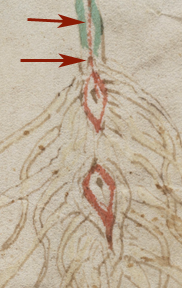 The roots are long and stringy, radiating from a larger central mass that includes two eye-like forms rimmed in red. This is the most curious part of the drawing as the unusual shapes look like they might have symbolic significance. Note that there is a red line extending from the top “eye” into the stem that does not continue down to the lower eye.
The roots are long and stringy, radiating from a larger central mass that includes two eye-like forms rimmed in red. This is the most curious part of the drawing as the unusual shapes look like they might have symbolic significance. Note that there is a red line extending from the top “eye” into the stem that does not continue down to the lower eye.
Other Curiosities
This folio is also unusual in that it includes a fairly long line of marginalia along the top, in a hand that resembles the handwriting on the last folio. Unfortunately most of the text to the right is faded and almost impossible to see. This folio also has some unusual characters next to the plant, including a diminutive version of one of the VMS glyphs which is usually drawn like a capital letter. The marginalia is a subject on its own, and will be discussed in a separate blog.
Prior Identifications
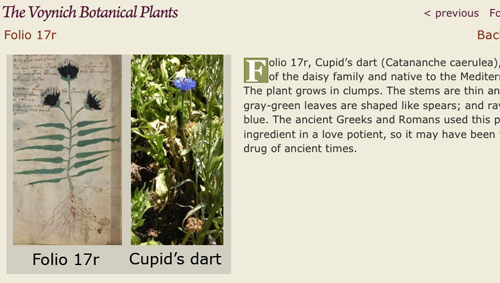 Edith Sherwood has identified Plant 17r as Catananche caerulea. I disagree with quite a few of Sherwood’s plant IDs, but this one seems reasonable for a number of reasons: the VMS flowers have been painted blue and appear as “puffs” at the end of slender stems, and the leaves are narrow. The common name of “Cupid’s Dart” from an ancient Greek and Roman practice of using the plant in love potions might also fit the shapes in the VMS root.
Edith Sherwood has identified Plant 17r as Catananche caerulea. I disagree with quite a few of Sherwood’s plant IDs, but this one seems reasonable for a number of reasons: the VMS flowers have been painted blue and appear as “puffs” at the end of slender stems, and the leaves are narrow. The common name of “Cupid’s Dart” from an ancient Greek and Roman practice of using the plant in love potions might also fit the shapes in the VMS root.
Sherwood didn’t comment on the imagery in the roots. The long, stringy unpainted tendrils include two eye-like almond-shaped forms with a dark dot inside and a lining of red around the rim. Red pigment has been used sparingly in the plant images, so the use of red in such a specific way might be significant. It’s not uncommon to find roots with holes or hollows or with red in the roots, but this specific shape and the double nature of the “eyes” is unusual.
What are Those Eye Shapes?
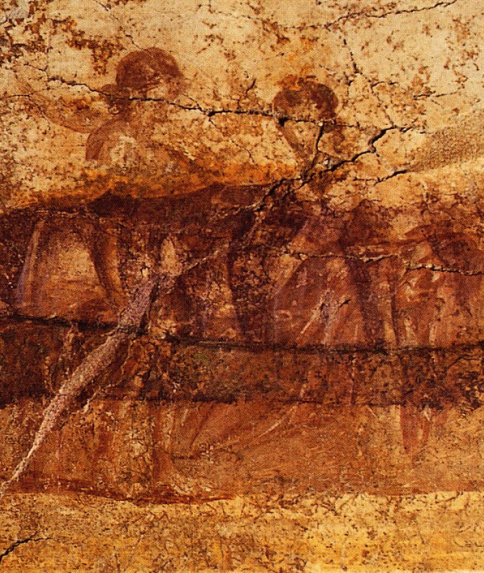 The resemblance to the opening of a vagina would be difficult to dispute, and would fit if the plant is an ingredient in love potions, although it doesn’t entirely explain why there are two red shapes. Could this be a reference to lesbian love? Male homosexual imagery was very common in classical Geek pottery, but not very common in medieval times. Images of lesbian love are rare in all historic time periods. The female erotic painting on the right, from the walls of Pompeii, is one of the few that has come down to us from ancient times.
The resemblance to the opening of a vagina would be difficult to dispute, and would fit if the plant is an ingredient in love potions, although it doesn’t entirely explain why there are two red shapes. Could this be a reference to lesbian love? Male homosexual imagery was very common in classical Geek pottery, but not very common in medieval times. Images of lesbian love are rare in all historic time periods. The female erotic painting on the right, from the walls of Pompeii, is one of the few that has come down to us from ancient times.
Perhaps the VMS “eyes” are not two vaginas. Maybe one eye-shape is intended as a vagina and the other as an anus (I know, it’s not a very polite term, but if that’s what it is, we might as well say it). It’s even possible those long stringy roots are intended to double as pubic hair.
When you have a document that is carefully crafted, extensive, and yet unreadable, it’s possible that forbidden subjects are hidden in the text and possibly also encoded into the drawings. The manuscript has an unusual preponderance of female nymphs (only a few appear to be male) which might be another reference to lesbianism, but not much has been said about this subject, and the manuscript as a whole seems more clinical than erotic, and doesn’t appear to confirm this idea. Still, the possibility should remain open until more is known.
Getting back to the plant ID…
Other Possible IDs
Even though Catananche caerulea might be a reasonable ID, given the shape of the plant and its relation to love potions, I didn’t want to assume it was the only one possible. The VMS flowers look quite thick and dense, in contrast to the light airy petals of C. caerulea and C. caerulea has alternate, somewhat clasping, droopy leaves, while the VMS leaves are opposite, straight, and distinctively horizontal, so I searched for a closer match.
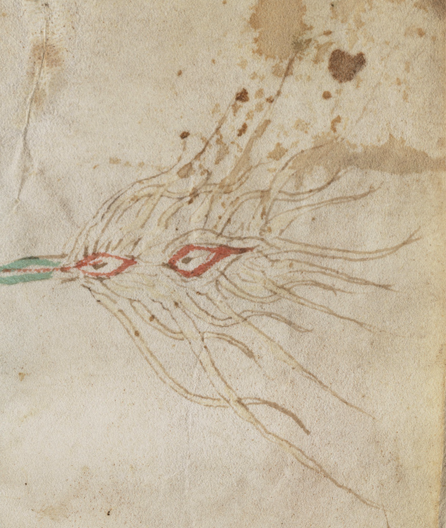 It occurred to me, when looking at the root, that if the two red shapes are eyeballs, then turning the root sideways is reminiscent of certain forms of sea-life, a resemblance that occurs in a few other VMS plants, such as the root that looks like an octopus and another that looks like a jellyfish.
It occurred to me, when looking at the root, that if the two red shapes are eyeballs, then turning the root sideways is reminiscent of certain forms of sea-life, a resemblance that occurs in a few other VMS plants, such as the root that looks like an octopus and another that looks like a jellyfish.
If one turns the root upside-down, it has a rather torch-like appearance, like two candle flames radiating waves of heat. There are quite a few plants that are dipped in wax and lit to create torches, such as Aaron’s rod (Verbascum), but it’s usually the stem and flowers, rather than the roots, that are used.
Plant 17r is a rather fun image incorporating shapes that could be interpreted in many different ways.
Searching for a Better Match
There are many plants with leaves like 17r, but most of them don’t have puffy flowers—many have flower spikes, bell-shaped blossoms, or a small number of petals. The challenge is to find a plant that matches all characteristics of the drawing. Some of the Dianthus plants with multiple petals are similar, but they tend to have clasping leaves, unlike Plant 17r.
Phylica capitata has slender, opposite leaves, but they are not as long as 17r.
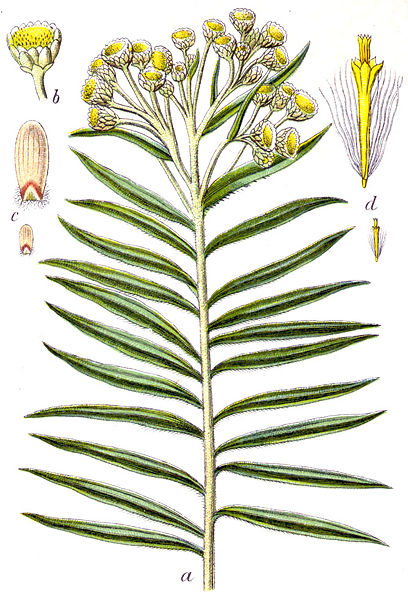 There is a plant that has very stiff, somewhat horizontal leaves, in the aster family, called Anaphalis (see left)—known to many people as “pearly everlasting”. The blossoms have a papery texture and, when dried, retain their original color, making them a favorite in dried flower arrangements. The roots often have a slightly knobby portion with many long stringy root hairs, similar to the VMS root. The flowers are quite dense, like those of the VMS plant, but they are not typically blue. Most are white or pink with yellow centers and the plant is not native to Europe—it is from India, parts of east Asia, and North America.
There is a plant that has very stiff, somewhat horizontal leaves, in the aster family, called Anaphalis (see left)—known to many people as “pearly everlasting”. The blossoms have a papery texture and, when dried, retain their original color, making them a favorite in dried flower arrangements. The roots often have a slightly knobby portion with many long stringy root hairs, similar to the VMS root. The flowers are quite dense, like those of the VMS plant, but they are not typically blue. Most are white or pink with yellow centers and the plant is not native to Europe—it is from India, parts of east Asia, and North America.
One of the problems with identifying the VMS plant is deciding whether the opposite leaves are literal. If they are, then 17r is neither Catananche or Anaphalis which both have alternate leaves. I’ve spent a significant amount of time evaluating all the plants to try to determine which aspects are symbolic, which are referential (not necessarily literal), and which are literal. I have the impression that leaf margins, veins, and possibly the leaf arrangements are meant to be naturalistic in many of the plants. The roots sometimes have fanciful embellishments, but perhaps they are meant to be mnemonic, as in many traditional herbals. If the 17r leaves are meant to be literal, then perhaps there are other plants that should be considered.
Further Possibilities
Valerian has long narrow leaves and a slightly bulbous root with long stringy root hairs, but the leaves do not branch off the main stem, they are odd-pinnate and there is another VMS plant that more closely resembles Valeriana than 17r.
Scabiosa suceisa has roots and flowers that resemble Plant 17r. The roots come from a thicker middle portion and branch out into long white, stringy tendrils. The flowers are dense with a slightly protruding calyx, and they are often a deep violet color, but the leaves are wider than Plant 17r and come up mostly from the base of the plant—they do not distribute themselves evenly along the stem. But…
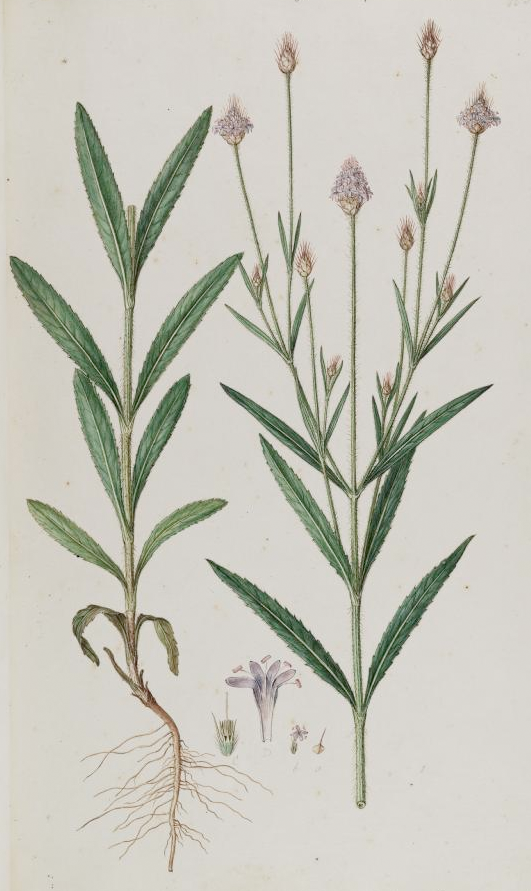 …there is another “Scabiosa” that might qualify. Scabiosa syriaca (Cephalaria syriaca—right), commonly called Makhobeli, has puffy flowers and long slender opposite leaves. It originated in Syria and has spread across Eurasia. The seeds are used as a flavoring for bread but it was not traditionally used as medicine and no particular significance has been given to the roots, nor could I find any records of a relationship to eyes or to female concerns. Morphologically it matches well to Plant 17r, but it doesn’t seem related in other ways.
…there is another “Scabiosa” that might qualify. Scabiosa syriaca (Cephalaria syriaca—right), commonly called Makhobeli, has puffy flowers and long slender opposite leaves. It originated in Syria and has spread across Eurasia. The seeds are used as a flavoring for bread but it was not traditionally used as medicine and no particular significance has been given to the roots, nor could I find any records of a relationship to eyes or to female concerns. Morphologically it matches well to Plant 17r, but it doesn’t seem related in other ways.
There is a SW African plant called Mesembryanthemum viridiflorum that has puffs of flowers, very stiff opposite leaves growing from long stems, and a knobby root, but the calyx is very long and almost wraps around the flowers, and the leaves don’t have petioles and are not as long as the leaves of 17r. It is not as upright as the VMS plant either. I thought it was worth mentioning due to the shape of the flowers and the opposite leaves, but I don’t think it’s a close match to the VMS.
Getting Closer
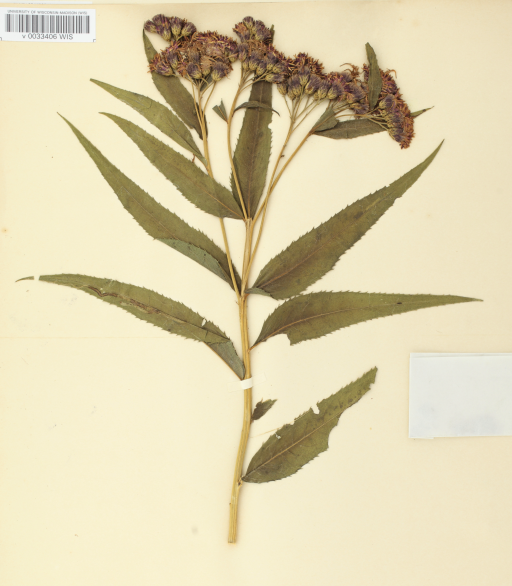
Vernonia fasiculata courtesy of Wisconsin Flora.
Vernonia crinita, Vernonia fasciculata, and Vernonia noveboracensis have more in common with Plant 17r than most plants, including those already mentioned. They are erect, with long, narrow, opposite leaves (or a mixture of alternate and opposite), and branching puffy purple flower heads that become darker and stiffer when they turn to seed. The roots of V. fasiculata look very much like the VMS roots, a thick mat of long stringy whitish tendrils.
There is also a Hawaiian species of Vernonia with opposite leaves, but the leaves are stubbier than most of the North American species.
Summary
So there is a plant that closely resembles the VMS plant on all counts: thick puffy branching flowers, long thin opposite leaves distributed evenly up the stem, and a long stringy whitish root. Sometimes the stem is red.
The oil from Vernonia is commercially used as a binder and the roots of certain North American species are used as a tonic for certain female conditions, which might explain the imagery in the VMS roots.
Unfortunately, varieties of Vernonia that most closely resemble the VMS plant are not native to Europe. If Plant 17r is Vernonia, the VMS illustrator would have to know New World plants to include it, and other aspects of the manuscript lean toward a pre-Columbus timeline. Even so, I prefer not to assume an exact date for the creation of the VMS, It simply feels to me, on a detail-by-detail basis, to be an earlier date, possibly late 14th century or thereabouts.
Because Vernonia matches so well compared to other options, I searched for Vernonia species with origins in the Old World and discovered that Vernonia galamensis is native to east Africa. This seemed promising until I noticed that V. galamensis has alternate leaves (which is also true of some of the New World Vernonias). It is less like the VMS drawing than the New World varieties mentioned above.
So, unless one is willing to accept that the VMS illustrator knew about New World plants, there are no perfect Old World matches, but the latter ones above are fairly close. As for the interpretation of the shapes in the root, there are many possibilities, some of which were socially taboo in the Middle Ages.
J.K. Petersen
© Copyright 2013 All Rights Reserved

